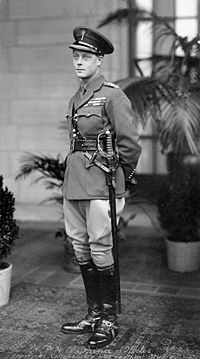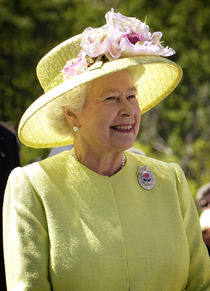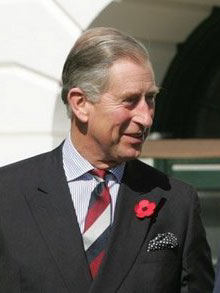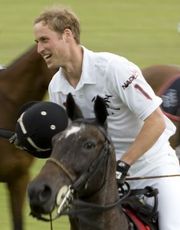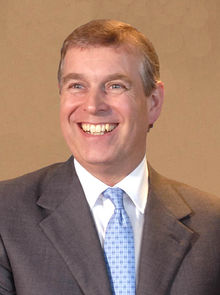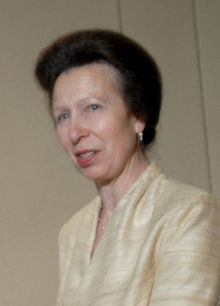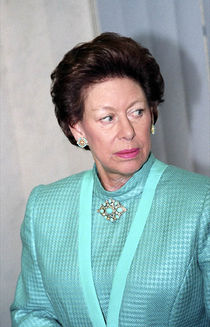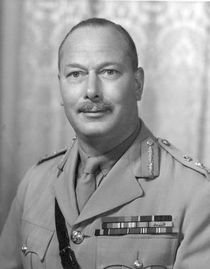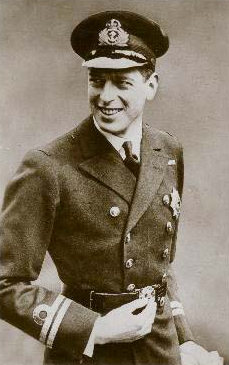House of Windsor
 |
|
| Country | Antigua and Barbuda, Australia, the Bahamas, Barbados, Belize, Canada, Grenada, Jamaica, New Zealand, Papua New Guinea, Saint Kitts and Nevis, Saint Lucia, Saint Vincent and the Grenadines, Solomon Islands, Tuvalu and the United Kingdom |
|---|---|
| Ancestral house |
|
| Titles | Various |
| Founder | George V |
| Current head | Prince Richard, Duke of Gloucester |
| Founding | 1917 |
The House of Windsor is the current Royal House of the United Kingdom and each of the other Commonwealth realms. It is a branch of the German House of Saxe-Coburg and Gotha (German: Sachsen-Coburg und Gotha), which adopted the English name Windsor by a royal proclamation on the 17. July 1917. The most prominent member of the House of Windsor is Elizabeth II, the reigning monarch over the Commonwealth realms.[1] However, the head of the House of Windsor (cadet branch of Saxe-Coburg-Gotha) is Prince Richard, Duke of Gloucester, as the senior male-line descendant of King George V, who founded the house by changing its name from Saxe-Coburg-Gotha to Windsor. The overall head of the House of Saxe-Coburg and Gotha, including the Windsor branch, is Andreas, Prince of Saxe-Coburg and Gotha. The heir to the thrones of the Commonwealth realms, Charles, Prince of Wales, is a member of a distinct House of Windsor, a cadet branch of the House of Schleswig-Holstein-Sonderburg-Glücksburg as membership to European royal houses is determined by patrilineal descent.
Contents |
Descendants of Victoria
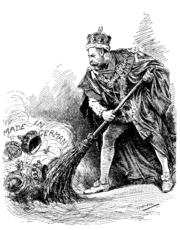
Queen Victoria was married to Prince Albert of Saxe-Coburg and Gotha – son of Duke Ernst I of the small German duchy of Saxe-Coburg and Gotha. Her descendants were also members of the ducal family of Saxe-Coburg and Gotha, a minor branch of the thousand-year-old House of Wettin. It was Victoria's desire that her son rule as a member of the House of Wettin, instead of the House of Saxe-Coburg and Gotha, because she felt the older name would conjure images of the shared Saxon heritage of Germany and England. However, the name Wettin was never widely accepted. Victoria's son, Edward VII, and, in turn, his son, George V, reigned as members of this house.
High anti-German sentiment amongst the people of the British Empire during World War I reached a peak in March 1917, when the Gotha G.IV, a heavy aircraft capable of crossing the English Channel began bombing London directly. The aircraft became a household name, and coincidently was part of the name of the royal family. These bombings were coupled with the abdication of King George's first cousin, Nicholas II, the Tsar of Russia on 15 March 1917, which raised the specter of the eventual abolition of all the monarchies in Europe. The King and his family were finally convinced to abandon all titles held under the German Crown, and to change German titles and house names to anglicized versions. Hence, on 17 July 1917, a Royal Proclamation issued by George V declared
- Now, therefore, We, out of Our Royal Will and Authority, do hereby declare and announce that as from the date of this Our Royal Proclamation Our House and Family shall be styled and known as the House and Family of Windsor, and that all the descendants in the male line of Our said Grandmother Queen Victoria who are subjects of these Realms, other than female descendants who may marry or may have married, shall bear the said Name of Windsor...
Upon hearing that his cousin had changed the name of the British royal house to Windsor, German Emperor Wilhelm II remarked jokingly that he planned to see Shakespeare's play The Merry Wives of Saxe-Coburg-Gotha.
The name had a long association with British royalty, through the town of Windsor, Berkshire and Windsor Castle, a link reflected in the Round Tower of Windsor Castle being the basis of the badge of the House of Windsor. At the same time, Prince Louis of Battenberg adopted the surname Mountbatten, a partial translation into English. Prince Louis is the maternal grandfather of Prince Philip, Duke of Edinburgh.
Only a single person, Alastair Windsor, 2nd Duke of Connaught and Strathearn, who was not a descendant of George V, ever bore the surname Windsor, and he died without issue. So today the only living royal Windsors are the agnatic descendants of George V.
Descendants of Elizabeth II
.svg.png)
When Princess Elizabeth (as she then was) married Prince Philip of Greece and Denmark, the standard practice would be to adopt his family household name. Because he was a prince, Prince Philip did not have a surname but he was of the House of Schleswig-Holstein-Sonderburg-Glücksburg, a minor branch of the House of Oldenburg. Not wishing to repeat the difficulties of three decades previous, before his marriage Prince Philip renounced his titles and adopted the surname Mountbatten, which his maternal grandfather had created in 1917.
On 9 April 1952, Queen Elizabeth II officially declared her "Will and Pleasure that I and My children shall be styled and known as the House and Family of Windsor, and that my descendants who marry and their descendants, shall bear the name of Windsor."[2]. On 8 February 1960, the Queen confirmed that she and her children would continue to be known as the House and Family of Windsor, as would any agnatic descendants who enjoy the style (manner of address) of Royal Highness, and the title of Prince or Princess.[2] Still, Elizabeth also decreed that her agnatic descendants who do not have that style and title would bear the surname Mountbatten-Windsor.[2]
Any future monarch can change the dynastic name through a similar royal proclamation, but the Prince of Wales has not signaled any intention either way. Even if the agnatic descendants of the Queen would retain the name Windsor, they are and will remain to be members of the House of Oldenburg.
Members of the House of Windsor
George V had five sons, their descendants are shown in the table. Two of the descendants are deceased, as of this writing (Princess Margaret and Prince William of Gloucester), and seven are Catholic. The other 39 are the initial people in the line of succession. CA means excluded from succession due to being Roman Catholic or having married a Catholic.
| Succ.# | Name | Birth (& Death) | Image | |||||||||||||||||||||||||||||||||||||||||||||||||||||||||||||||||||||||||||||||||||||||||||||||||||||||||||||||||||||||||||||||||||||||||||||||||||||||||||||||||||||||||||||||||||||||||||||||||||||||||||||||||||||||||||||||||||||||||||||||||||||||||||||||||||||||||||||||||||||||
|---|---|---|---|---|---|---|---|---|---|---|---|---|---|---|---|---|---|---|---|---|---|---|---|---|---|---|---|---|---|---|---|---|---|---|---|---|---|---|---|---|---|---|---|---|---|---|---|---|---|---|---|---|---|---|---|---|---|---|---|---|---|---|---|---|---|---|---|---|---|---|---|---|---|---|---|---|---|---|---|---|---|---|---|---|---|---|---|---|---|---|---|---|---|---|---|---|---|---|---|---|---|---|---|---|---|---|---|---|---|---|---|---|---|---|---|---|---|---|---|---|---|---|---|---|---|---|---|---|---|---|---|---|---|---|---|---|---|---|---|---|---|---|---|---|---|---|---|---|---|---|---|---|---|---|---|---|---|---|---|---|---|---|---|---|---|---|---|---|---|---|---|---|---|---|---|---|---|---|---|---|---|---|---|---|---|---|---|---|---|---|---|---|---|---|---|---|---|---|---|---|---|---|---|---|---|---|---|---|---|---|---|---|---|---|---|---|---|---|---|---|---|---|---|---|---|---|---|---|---|---|---|---|---|---|---|---|---|---|---|---|---|---|---|---|---|---|---|---|---|---|---|---|---|---|---|---|---|---|---|---|---|---|---|---|---|---|---|---|---|---|---|---|---|---|---|---|---|---|---|---|---|---|
| Founder | HM George V | 3 June 1865 20 January 1936 (aged 70) |
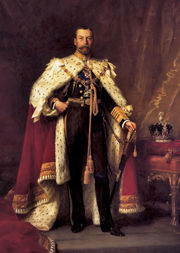 |
|||||||||||||||||||||||||||||||||||||||||||||||||||||||||||||||||||||||||||||||||||||||||||||||||||||||||||||||||||||||||||||||||||||||||||||||||||||||||||||||||||||||||||||||||||||||||||||||||||||||||||||||||||||||||||||||||||||||||||||||||||||||||||||||||||||||||||||||||||||||
| G-V |
|
|||||||||||||||||||||||||||||||||||||||||||||||||||||||||||||||||||||||||||||||||||||||||||||||||||||||||||||||||||||||||||||||||||||||||||||||||||||||||||||||||||||||||||||||||||||||||||||||||||||||||||||||||||||||||||||||||||||||||||||||||||||||||||||||||||||||||||||||||||||||||
Titles
Designation and details
At the creation of the House of Windsor, its head reigned over a unitary British Empire. Following the end of the First World War, however, geo-political shifts took place that saw the emergence of the dominions as sovereign states, the first step being the issuance of the Balfour Declaration in 1926, followed by the Royal and Parliamentary Titles Act the next year, and the Statute of Westminster in 1931. From then on, the House of Windsor became the royal house of multiple countries, a number that shifted over the decades as various Dominions and Crown colonies gained independence, and various of those moved to become monarchies under a different sovereign or a republic. Since 1949, the head of the House of Windsor is also Head of the Commonwealth of Nations, comprising most (but not all) parts of the former British Empire and some states that were never part of it.
In the chart below, the countries are differentiated between light green (realms of the House of Windsor as dominions), medium green (present realms of the House of Windsor), and dark green (former realms of the House of Windsor).
| 1920 | 1925 | 1930 | 1935 | 1940 | 1945 | 1950 | 1955 | 1960 | 1965 | 1970 | 1975 | 1980 | 1985 | 1990 | 1995 | 2000 | 2005 | 2010 | |||||||||||||||||||||||||||||||||||||||||||||||||||||||||||||||||||||||||||||
|---|---|---|---|---|---|---|---|---|---|---|---|---|---|---|---|---|---|---|---|---|---|---|---|---|---|---|---|---|---|---|---|---|---|---|---|---|---|---|---|---|---|---|---|---|---|---|---|---|---|---|---|---|---|---|---|---|---|---|---|---|---|---|---|---|---|---|---|---|---|---|---|---|---|---|---|---|---|---|---|---|---|---|---|---|---|---|---|---|---|---|---|---|---|---|---|
| Antigua and Barbuda | |||||||||||||||||||||||||||||||||||||||||||||||||||||||||||||||||||||||||||||||||||||||||||||||
| Australia | |||||||||||||||||||||||||||||||||||||||||||||||||||||||||||||||||||||||||||||||||||||||||||||||
| The Bahamas | |||||||||||||||||||||||||||||||||||||||||||||||||||||||||||||||||||||||||||||||||||||||||||||||
| Barbados | |||||||||||||||||||||||||||||||||||||||||||||||||||||||||||||||||||||||||||||||||||||||||||||||
| Belize | |||||||||||||||||||||||||||||||||||||||||||||||||||||||||||||||||||||||||||||||||||||||||||||||
| Canada | |||||||||||||||||||||||||||||||||||||||||||||||||||||||||||||||||||||||||||||||||||||||||||||||
| Ceylon | |||||||||||||||||||||||||||||||||||||||||||||||||||||||||||||||||||||||||||||||||||||||||||||||
| Fiji | |||||||||||||||||||||||||||||||||||||||||||||||||||||||||||||||||||||||||||||||||||||||||||||||
| The Gambia | |||||||||||||||||||||||||||||||||||||||||||||||||||||||||||||||||||||||||||||||||||||||||||||||
| Ghana | |||||||||||||||||||||||||||||||||||||||||||||||||||||||||||||||||||||||||||||||||||||||||||||||
| Grenada | |||||||||||||||||||||||||||||||||||||||||||||||||||||||||||||||||||||||||||||||||||||||||||||||
| Guyana | |||||||||||||||||||||||||||||||||||||||||||||||||||||||||||||||||||||||||||||||||||||||||||||||
| Indian Empire | |||||||||||||||||||||||||||||||||||||||||||||||||||||||||||||||||||||||||||||||||||||||||||||||
| Union of India | |||||||||||||||||||||||||||||||||||||||||||||||||||||||||||||||||||||||||||||||||||||||||||||||
| Irish Free State | |||||||||||||||||||||||||||||||||||||||||||||||||||||||||||||||||||||||||||||||||||||||||||||||
| Jamaica | |||||||||||||||||||||||||||||||||||||||||||||||||||||||||||||||||||||||||||||||||||||||||||||||
| Kenya | |||||||||||||||||||||||||||||||||||||||||||||||||||||||||||||||||||||||||||||||||||||||||||||||
| Malawi | |||||||||||||||||||||||||||||||||||||||||||||||||||||||||||||||||||||||||||||||||||||||||||||||
| Malta | |||||||||||||||||||||||||||||||||||||||||||||||||||||||||||||||||||||||||||||||||||||||||||||||
| Mauritius | |||||||||||||||||||||||||||||||||||||||||||||||||||||||||||||||||||||||||||||||||||||||||||||||
| New Zealand | |||||||||||||||||||||||||||||||||||||||||||||||||||||||||||||||||||||||||||||||||||||||||||||||
| Nigeria | |||||||||||||||||||||||||||||||||||||||||||||||||||||||||||||||||||||||||||||||||||||||||||||||
| Pakistan | |||||||||||||||||||||||||||||||||||||||||||||||||||||||||||||||||||||||||||||||||||||||||||||||
| Papua New Guinea | |||||||||||||||||||||||||||||||||||||||||||||||||||||||||||||||||||||||||||||||||||||||||||||||
| Saint Kitts and Nevis | |||||||||||||||||||||||||||||||||||||||||||||||||||||||||||||||||||||||||||||||||||||||||||||||
| Saint Lucia | |||||||||||||||||||||||||||||||||||||||||||||||||||||||||||||||||||||||||||||||||||||||||||||||
| St Vincent and the Grenadines | |||||||||||||||||||||||||||||||||||||||||||||||||||||||||||||||||||||||||||||||||||||||||||||||
| Sierra Leone | |||||||||||||||||||||||||||||||||||||||||||||||||||||||||||||||||||||||||||||||||||||||||||||||
| Solomon Islands | |||||||||||||||||||||||||||||||||||||||||||||||||||||||||||||||||||||||||||||||||||||||||||||||
| South Africa | |||||||||||||||||||||||||||||||||||||||||||||||||||||||||||||||||||||||||||||||||||||||||||||||
| Tanganyika | |||||||||||||||||||||||||||||||||||||||||||||||||||||||||||||||||||||||||||||||||||||||||||||||
| Trinidad and Tobago | |||||||||||||||||||||||||||||||||||||||||||||||||||||||||||||||||||||||||||||||||||||||||||||||
| Tuvalu | |||||||||||||||||||||||||||||||||||||||||||||||||||||||||||||||||||||||||||||||||||||||||||||||
| Uganda | |||||||||||||||||||||||||||||||||||||||||||||||||||||||||||||||||||||||||||||||||||||||||||||||
| United Kingdom | |||||||||||||||||||||||||||||||||||||||||||||||||||||||||||||||||||||||||||||||||||||||||||||||
| 1920 | 1925 | 1930 | 1935 | 1940 | 1945 | 1950 | 1955 | 1960 | 1965 | 1970 | 1975 | 1980 | 1985 | 1990 | 1995 | 2000 | 2005 | 2010 | |||||||||||||||||||||||||||||||||||||||||||||||||||||||||||||||||||||||||||||
List of Commonwealth realms monarchs
| Portrait | Name | From | Until | Relationship with predecessor |
|---|---|---|---|---|
 |
King Edward VII | 22 January 1901 | 6 May 1910 | son of Queen Victoria and Prince Albert of Saxe-Coburg and Gotha. |
.png) |
King George V | 6 May 1910 | 20 January 1936 | son of Edward VII. |
.jpg) |
King Edward VIII | 20 January 1936 | 11 December 1936 | son of George V; Abdicated. |
.png) |
King George VI | 11 December 1936 | 6 February 1952 | son of George V & brother of abdicated Edward VIII. |
 |
Queen Elizabeth II | 6 February 1952 | reigning | daughter of George VI. |
Timeline of Monarchs

House of Windsor and the Line of Succession
When the House of Windsor was created, the House of Windsor included George V and his children. However, there was no law passed to limit the Line of Succession. At this time the line was approaching a thousand people who were legitimately descended from George I and not disqualified by religion. In addition to the six Windsor children, the next five on the list were British. So, even considering the dangers of wartime, it was highly unlikely that a series of disasters would occur that resulted in the crown passing outside of the kingdom. Therefore it would not have been risky to limit the line to these eleven people.
The British members were followed by the royal members in Norway and Romania, and Tsar Nicholas II of Russia. The Tsar was descended from George I via three different bloodlines. The Tsar's wife was a first cousin of George V. Kaiser Wilhelm II, was also a first cousin of George V, sharing a common grandmother, Queen Victoria, so he was on the list. The line of succession was roughly half Germans. The line included all of the Kings of Prussia except the first king. The line of succession apparently did not disturb the public as much as the Germanic household names, the Germanic titles, and the photos of their King riding with the Emperor of Germany taken only three years earlier.
Further reading
- Longford, Elizabeth Harman (Countess of Longford). The Royal House of Windsor. Revised ed. Crown, 1984.
- Roberts, Andrew. The House of Windsor. University of California Press, 2000.
See also
- British Royal Family
- Canadian Royal Family
- Australian Royal Family
- New Zealand Royal Family
- Mountbatten-Windsor
- List of descendants of George V
- Windsor, Berkshire
- Windsor Castle
- History of the British line of succession
Notes and references
- ↑ "The Official Website of the British Monarchy". Queen's Printer. http://www.royal.gov.uk/#. Retrieved 1 May 2009.
- ↑ 2.0 2.1 2.2 Royal Styles and Titles – 1960 Letters Patent
External links
- Royal Family Name from royal.gov.uk
- House of Windsor from royal.gov.uk
- House of Windsor Tree from royal.gov.uk [Lord Culloden & Albert+Leopold Windsor are missing]
|
*Royal House*
House of Windsor
Cadet branch of the House of Wettin
|
||
| Preceded by House of Saxe-Coburg and Gotha |
Ruling House of the United Kingdom and the other Commonwealth realms. 1917–present |
Succeeded by Incumbent |
|
|||||||||||||||||||||||||||||||||||||||||||||||||||||||||||||||||||||||||||||||||||||||||||||||||||||||||||||||||||||||
